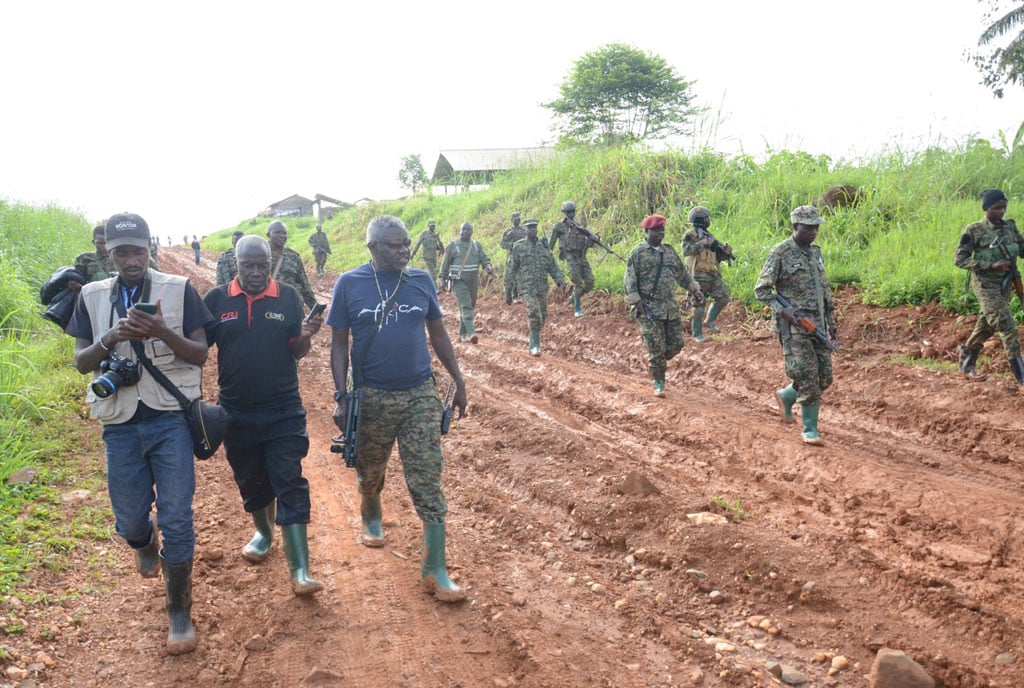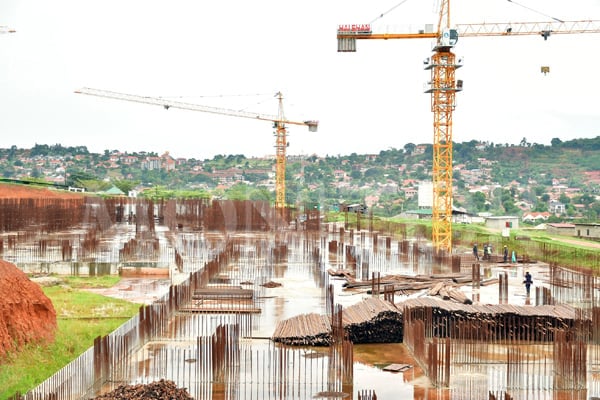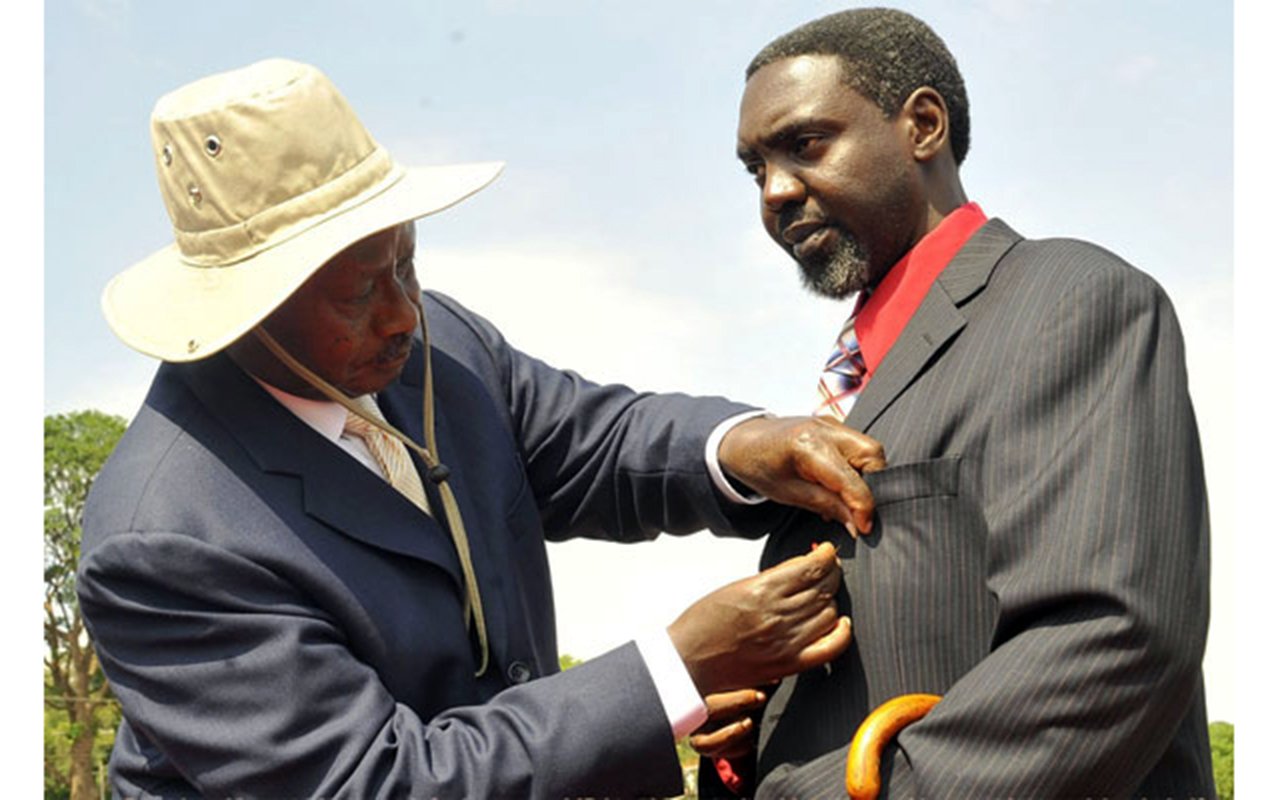Entering heart of Ituri province in DR Congo

The writer Alex Ashaba (Left) with Operation Shujaa commander Maj Gen Dick Olum in Ituri province eastern DR Congo. PHOTO/
What you need to know:
- Into the forest. To acquaint journalists with Operation Shujaa which marked two years in DR Congo, Alex Ashaba was one of the journalists invited to Ituri Province in eastern DR Congo.
Time check: 7.30am on November 28,2023. We set off from Fort Portal City aboard a UPDF van packed with soldiers destined for Ituri Province in eastern DR Congo. This marked the commencement of our activities on Operation Shujaa, which had so far spent two years dedicated to tracking down Allied Defence Force (ADF) rebels in the jungles of eastern DRC since November 30, 2021.
Meanwhile Lt Col Edison Kwesiga had recommended that everyone carries extra clothing, precisely a pair of gumboots, emphasizing the challenging terrain and impassable roads in the jungle we were headed for.
Our initial stopover was Rugedabara, just a few kilometres beyond the border of the Bunyangabu District into Kasese District, where we bought drinks. Then in Kasese Town where we had breakfast. As we prepared to resume our journey, excitement was palpable. However, it was announced that another vehicle, transporting armed soldiers, would rendezvous with us at Mpondwe, the Uganda -DR Congo border in Kasese District to offer us more security.
The road on the Ugandan side was paved up to the border. At the border, we spent several hours before departing around 3pm and entered DR Congo.
In Kasindi
Our first destination in DR Congo was Kasindi, a town where business carried on as usual. Inside the van, one soldier revealed that a few days prior, ADF rebels had attacked the area where cargo trucks were parked, resulting in the shooting of two UPDF soldiers.
The presence of armed individuals in uniform patrolling the area became evident. The muddy, uneven roads punctuated with stones, led us onto the Kasindi-Beni Road, an 80-kilometre stretch currently under construction by Dott Services. This road traverses the Virunga National Park, with the national park visible on the left and people’s gardens to the right. The area was sparsely populated, and signs of armed patrols were conspicuous.
The vehicles along the route were primarily loaded with construction materials alongside a few cargo trucks. At various intervals, UPDF-armed cars with soldiers were stationed. We reached Beni Town at 6pm.
Streets adorned with campaign posters of different presidential candidates; the town bustled with activity. The road from Beni to Luna, our destination was paved. Approximately 20 kilometres from Beni, forests of Ituri province flanked both sides of the road. The journey revealed a stark reality—abandoned houses, churches, and small trading centres.
As we ventured further about 20 kilometres from Beni, the presence of vehicles heading in the same direction dwindled. Motorbikes were majority means of transport. And one could hear a pin drop.
Luna
At 7pm, we arrived at sector four of Operation Shuja in Luna. This area had served as a UPDF camp base for about a month. Maj Gen Dick Olum, the commander of the operation led our reception.
“Welcome to the jungle; this place may feel like hell on earth, but you are safe. We established this sector just about a month ago,” the commander stated.
Soldiers had set up their small tents for accommodation. We were ushered into a large tent where, after some discussions and interactions with the commander, dinner was served. Some of us had brought along additional provisions.
I slept alone in tent one, and before retiring for the night, we gathered around a bonfire at midnight. The directive was: ‘wake up at 6.300am Ugandan time to begin the day’s work’.
Journeying into the jungles
The following morning, after personal administration, preparations commenced at 7am for the journey into the jungles. A morning brief outlined the details of how to move, which vehicles to board, and the fact that all the vehicles would be pickup trucks, forming a convoy led by the operation commander and other technical officers.
From the camp base, the road initially seemed impassable. However, the vehicles skillfully navigated the rugged terrain. We visited Makindye Battalion, one of the battalions, offering insights into their activities.
Meanwhile sights of burnt vehicles and abandoned structures dotted the roadside with isolated houses in the bush. Then, we go to Ndalya, the trading area where some residents had resettled near established camps of the DR Congo army and UPDF.
Along the way, we encountered residents carrying merchandise, including food. When we interacted, they lamented about the ruinous impact of ADF rebels on their lives. Many lost siblings to the insurgency. Despite the uncertainty of the next day, due to potential rebel attacks, those who persisted and returned to their homes, expressed gratitude for the presence of the UPDF in their area.
Communicating in the jungle using a Ugandan Sim card proved impossible due to the lack of telecom signal coverage, making it hard for those who enjoy social media. But, on the second day, the UPDF commander of the operation facilitated connectivity via hotspots, allowing communication through various social media handles.
Bad terrain
Sections of the roads were non-motorable and we had to disembark and proceed on foot. At times, vehicles got stuck in the mud, requiring collective efforts to push them back onto the road.
The road network from Luna to Komando covered approximately 75 kilometres in its current state.
While progressing along the route, after Ndalya trading area, we encountered a deep spot that proved impassable for regular vehicles. Operation commander Maj Gen Olum called in some soldiers and came with an excavator and other road unit equipment, and the efforts to address the obstacle spanned over three hours.
Return
Upon our return to Uganda on November 30, at 8.15 Ugandan time (DR Congo being one hour ahead), trading centres on the Beni-Luna Road in the Erigeti area were busy. People tended cassava and maize gardens, and the preferred mode of transport was boda boda.
In areas once abandoned by locals, only signposts remained standing in the bush. We found cocoa gardens in Mayimoya, Oicha, and Mavivi, contributing to the economic activities of these regions.
Some towns exhibited traffic with traffic officers on the streets. DR Congo had also established army detachments to ensure security.
The bumps
Challenges arose as some sections of the road were muddy and non-motorable. In such instances, we had to disembark and proceed on foot, as the vehicles could not navigate the difficult terrain.
At times, vehicles got stuck in some soldiers and came with an excavator and other road unit equipment, and the efforts to address the obstacle spanned over three hours.




